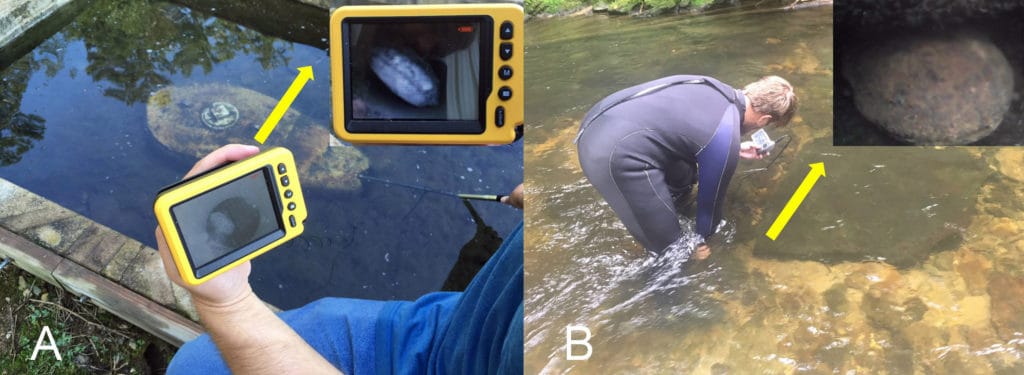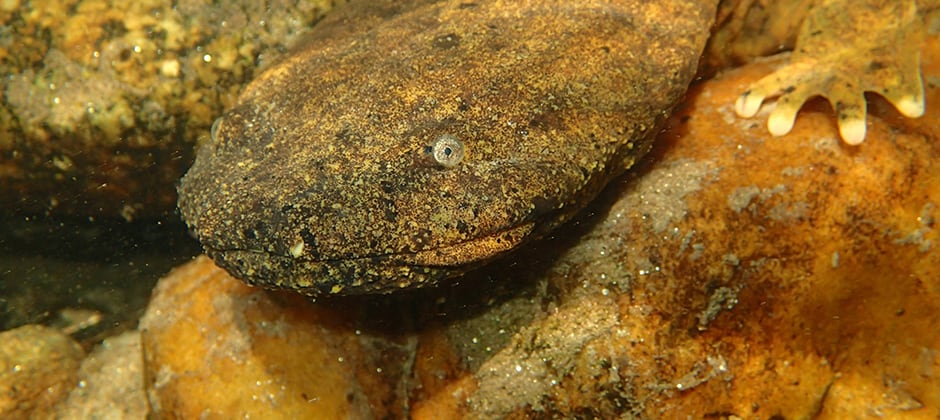Share this article
Underwater videos improve hellbender conservation
Underwater videos can help researchers find hellbenders without damaging or permanently scaring them away the rocks where they nest.
Eastern hellbenders (Cryptobranchus alleganiensis) are elusive and hard to detect, though many researchers believe the amphibians are declining in parts of their range in Alabama and Georgia.
One of the best ways to find these amphibians is during their breeding season, when they are more mobile and easier to detect. Traditionally, researchers have done this by lifting up rocks they may be breeding under.
Hellbenders, the largest salamander species in North America, choose nests carefully throughout their range in the eastern United States. Male hellbenders stake out spots under large rocks in streams. They guard them from rivals until females come by and lay their eggs, then continue to guard the eggs until larvae hatch.
But by lifting up rocks, researchers have found, they can scare the hellbenders away from prime nesting locations. “Inadvertently, we might be disturbing their preferred nest rock,” said Shem Unger, an assistant professor at Wingate University in North Carolina and the lead author of a study published recently in Aquaculture and Fisheries on a new technique for biologists to detect the salamanders.
In the worst case, by disturbing males guarding the eggs, researchers may even prompt them to cannibalize their own eggs — perhaps because they believed they were in significant danger from predators in the first place.
Some wildlife managers have tried artificial nest boxes for hellbenders, with tops that open for researchers to check for nests. While this approach has had limited success, it has sometimes also resulted in nest failure.
To avoid disturbing the nests, some researchers have turned to using environmental DNA to detect the presence or absence of hellbenders in a waterway. And while this type of technology is growing, it doesn’t allow researchers to pinpoint where the nests are. This is important for conservationists looking to collect eggs for captive rearing or head-starting to improve survival in wild, or for translocation to areas where numbers are in decline.

Researchers showing the difference between an Aqua-Vu camera (A), on an artificial nest box in a hellbender hatchery, and a borescope (B) in a natural rock nest. ©Shem Unger
Unger and his co-authors wanted to test the ability of underwater cameras to spot hellbenders under rocks. They used two types of cameras to see if they could detect the amphibians in North Carolina streams: Aqua-Vu devices, equipped with infrared sensors for low light, which are often used in ice-fishing; and borescopes, the long, tube-like cameras plumbers often use to see down narrow pipes.
“We can use underwater video cameras to detect the presence of individuals without lifting a rock and destroying the habitat,” Unger said.
Unger said that both devices worked well in different ways. The borescopes were more flexible, and could more easily be maneuvered into small, tighter areas. The Aqua-Vu cameras were better in areas filled with sediment. Because its infrared capabilities help in low light, Unger said, it could be the better choice if it were equipped with a pole to help it reach some areas.
He’s also testing GoPro cameras to see how they compare to the other two types and has noticed that they allow biologists to watch movements for longer, but he’s still conducting research on these.
Videos could be a less intrusive method for nest detection or egg counts.
Header Image: Hellbenders are hard to detect without the risk of disturbing their nesting sites. @Shem Unger








